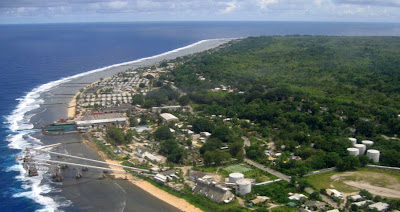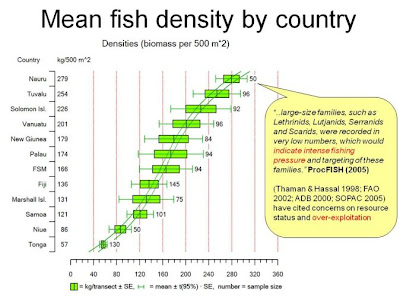The Nauru delegation at the biennial Pacific Islands Heads of Fisheries meeting yesterday supported a regional consensus to protect “SPAGs”.
To the cynical this may sound like a movement to protect a culinary delicacy, but “SPAGs” actually ARE a culinary delicacy for most Pacific Islanders. The acronym “SPAGs” stands for reef fish “Spawning Aggregations”.
Although only recently studied by fishery scientists and reef ecologists, Pacific Islanders have known for centuries about the tendency of many species of reef fish to gather together at particular spots on the reef during the breeding season. This “nightclubbing” strategy improves both breeding success and protection from natural predators.
Unfortunately, modern fishing techniques, particularly SCUBA and torch spearfishing, have turned human beings into much more efficient predators than anything faced by reef fish for millions of years. And SPAGS make particularly tempting targets.
A 2005 underwater survey of Nauru reef fish by NFMRA, with assistance from SPC, showed that although Nauru has a small reef it has a relatively high biomass of reef fish per unit area, when compared to most other Pacific Island countries. This is because most of the available reef area in Nauru is “fore-reef”. It is highly productive compared to the lagoon and back-reef -dominated coasts of many other Pacific Islands.
 |
| The Nauru fringing reef is relatively narrow, oceanic & energetic |
This sounds good, but when we look at the species that make up the majority of that biomass, things are not quite so rosy. Put simply, the Nauru reef doesn’t have many big fish on it. The species assemblage is now dominated by small species, particularly surgeonfish and triggerfish.
The bigger species – the groupers, snappers, coral trouts and cods – are highly sought after and also tend to be species which temptingly gather into spawning aggregations at certain times of year.
The International Coral Reef Initiative meeting in Samoa recently made some recommendations about how Pacific Island fisheries departments might help protect their SPAGs. With support from the Society for the Conservation of Reef Fish Aggregations and the Coral Reef Initiative for the South Pacific, these recommendations have just been put before Pacific Island fisheries managers at the SPC Heads of Fisheries Meeting (HoF) that is currently taking place in Noumea.
Yesterday, HoF accepted and endorsed these recommendations, and Nauru spoke in support of the consensus. Monte Depaune, the head of the Nauru delegation, pointed out that in order to implement these regional recommendations at a local level it would be very helpful to have some regional assistance in training NFMRA underwater survey teams in identifying and assessing SPAGS.
He also drew attention to the fact that the Nauru National Sustainable Development Strategies (NSDS) were recently updated and a national goal of establishing, through community consultation, Marine Protected Areas has been set in Nauru. It would make sense for the boundaries of some of these protected areas to enclose or include significant reef fish spawning aggregation sites, and it will thus be necessary to present information about these sites to Nauruan communities.
National efforts to achieve this NSDS goal will involve collaboration between the Nauru Fisheries and Marine Resources Authority (NFMRA) and the Department of Commerce, Industry and Environment (CIE), as well as directly consulting and involving Nauru people.


